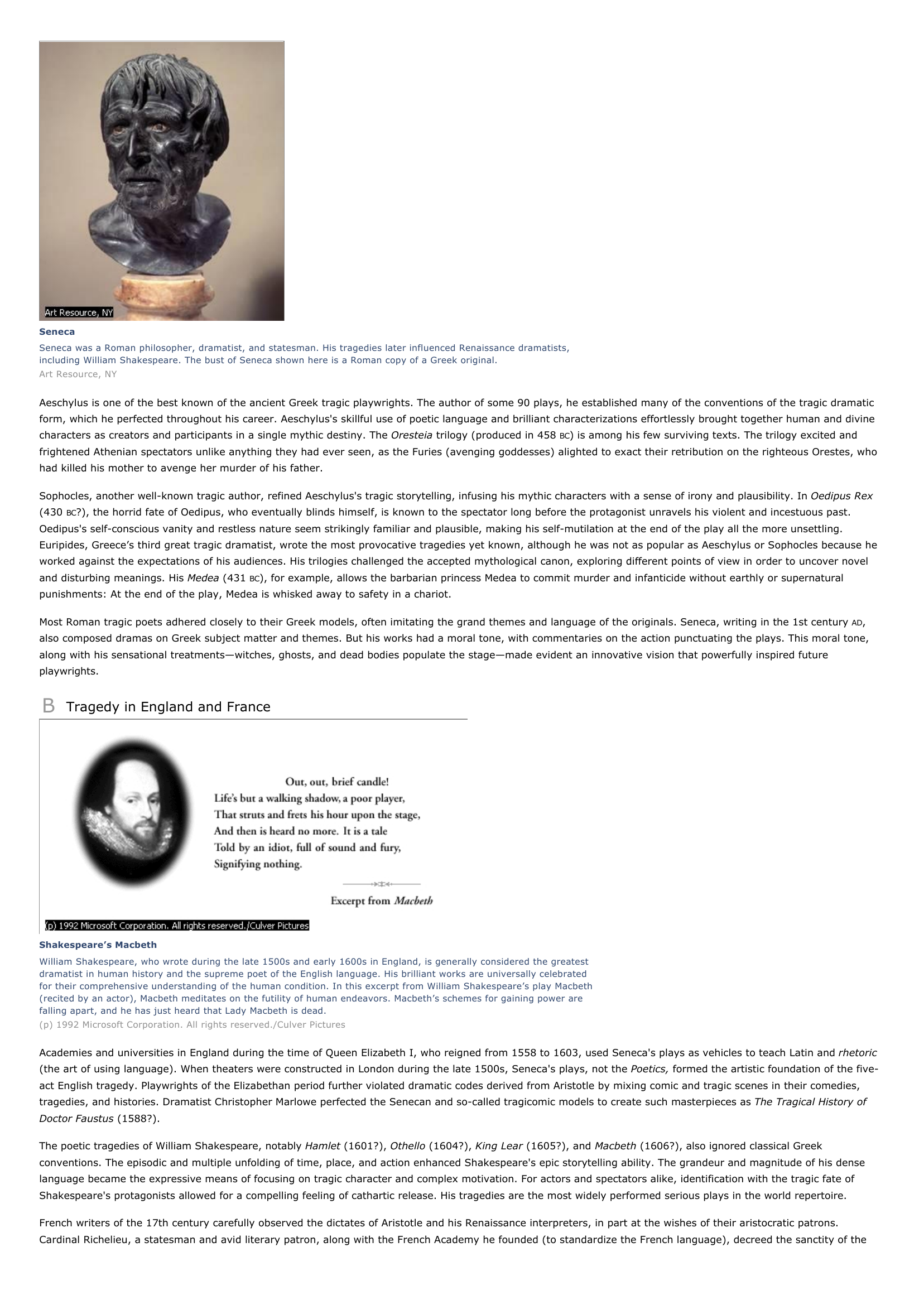Tragedy I INTRODUCTION Euripides Unlike other 5th-century BC Greek playwrights, tragic poet Euripides addressed the plight of the common people, rather than that of mythic heroes.
Publié le 12/05/2013

Extrait du document
«
SenecaSeneca was a Roman philosopher, dramatist, and statesman.
His tragedies later influenced Renaissance dramatists,including William Shakespeare.
The bust of Seneca shown here is a Roman copy of a Greek original.Art Resource, NY
Aeschylus is one of the best known of the ancient Greek tragic playwrights.
The author of some 90 plays, he established many of the conventions of the tragic dramaticform, which he perfected throughout his career.
Aeschylus's skillful use of poetic language and brilliant characterizations effortlessly brought together human and divinecharacters as creators and participants in a single mythic destiny.
The Oresteia trilogy (produced in 458 BC) is among his few surviving texts.
The trilogy excited and frightened Athenian spectators unlike anything they had ever seen, as the Furies (avenging goddesses) alighted to exact their retribution on the righteous Orestes, whohad killed his mother to avenge her murder of his father.
Sophocles, another well-known tragic author, refined Aeschylus's tragic storytelling, infusing his mythic characters with a sense of irony and plausibility.
In Oedipus Rex (430 BC?), the horrid fate of Oedipus, who eventually blinds himself, is known to the spectator long before the protagonist unravels his violent and incestuous past. Oedipus's self-conscious vanity and restless nature seem strikingly familiar and plausible, making his self-mutilation at the end of the play all the more unsettling.Euripides, Greece’s third great tragic dramatist, wrote the most provocative tragedies yet known, although he was not as popular as Aeschylus or Sophocles because heworked against the expectations of his audiences.
His trilogies challenged the accepted mythological canon, exploring different points of view in order to uncover noveland disturbing meanings.
His Medea (431 BC), for example, allows the barbarian princess Medea to commit murder and infanticide without earthly or supernatural punishments: At the end of the play, Medea is whisked away to safety in a chariot.
Most Roman tragic poets adhered closely to their Greek models, often imitating the grand themes and language of the originals.
Seneca, writing in the 1st century AD, also composed dramas on Greek subject matter and themes.
But his works had a moral tone, with commentaries on the action punctuating the plays.
This moral tone,along with his sensational treatments—witches, ghosts, and dead bodies populate the stage—made evident an innovative vision that powerfully inspired futureplaywrights.
B Tragedy in England and France
Shakespeare’s MacbethWilliam Shakespeare, who wrote during the late 1500s and early 1600s in England, is generally considered the greatestdramatist in human history and the supreme poet of the English language.
His brilliant works are universally celebratedfor their comprehensive understanding of the human condition.
In this excerpt from William Shakespeare’s play Macbeth(recited by an actor), Macbeth meditates on the futility of human endeavors.
Macbeth’s schemes for gaining power arefalling apart, and he has just heard that Lady Macbeth is dead.(p) 1992 Microsoft Corporation.
All rights reserved./Culver Pictures
Academies and universities in England during the time of Queen Elizabeth I, who reigned from 1558 to 1603, used Seneca's plays as vehicles to teach Latin and rhetoric (the art of using language).
When theaters were constructed in London during the late 1500s, Seneca's plays, not the Poetics, formed the artistic foundation of the five- act English tragedy.
Playwrights of the Elizabethan period further violated dramatic codes derived from Aristotle by mixing comic and tragic scenes in their comedies,tragedies, and histories.
Dramatist Christopher Marlowe perfected the Senecan and so-called tragicomic models to create such masterpieces as The Tragical History of Doctor Faustus (1588?).
The poetic tragedies of William Shakespeare, notably Hamlet (1601?), Othello (1604?), King Lear (1605?), and Macbeth (1606?), also ignored classical Greek conventions.
The episodic and multiple unfolding of time, place, and action enhanced Shakespeare's epic storytelling ability.
The grandeur and magnitude of his denselanguage became the expressive means of focusing on tragic character and complex motivation.
For actors and spectators alike, identification with the tragic fate ofShakespeare's protagonists allowed for a compelling feeling of cathartic release.
His tragedies are the most widely performed serious plays in the world repertoire.
French writers of the 17th century carefully observed the dictates of Aristotle and his Renaissance interpreters, in part at the wishes of their aristocratic patrons.Cardinal Richelieu, a statesman and avid literary patron, along with the French Academy he founded (to standardize the French language), decreed the sanctity of the.
»
↓↓↓ APERÇU DU DOCUMENT ↓↓↓
Liens utiles
- erbs Greek The mythic power of herbs to transform people and to restore life to the dead features prominently in several Greek myths.
- Wolfgang Amadeus Mozart I INTRODUCTION Wolfgang Amadeus Mozart Wolfgang Amadeus Mozart, an 18th-century Austrian classical composer and one of the most famous musicians of all time, came from a family of musicians that included his father and sister.
- Homer I INTRODUCTION Homer According to tradition, the Greek poet Homer is believed to be the author of the Iliad and the Odyssey, two great epics of ancient Greek literature.
- William Faulkner I INTRODUCTION William Faulkner Twentieth-century American novelist William Faulkner wrote novels that explored the tensions between the old and the new in the American South.
- Indian Music I INTRODUCTION Classical Dance of South India The southern Indian kathakali is a dance drama that dates from the 17th century.


















